What ingredients make the world's greatest cocktail bar?
 Rob Lawson
Rob LawsonNew York likes to think of itself as the home of the cocktail. But these days, London's scene is giving the Big Apple a run for its money. So when it comes to picking the world's greatest cocktail bar, which city wins? Elizabeth Hotson went to find out.
From the Gin Rickey and Mint Julep swilling characters in The Great Gatsby, to the Mad Men who can't get enough Manhattans and Whiskey Sours, in the past it's New York that has tended to put the fizz into fancy mixed drinks.
But these days, for true flaunt-it decadence, London's hotel bars are hard to beat.
Take, for example, The Connaught Bar. At 5pm on a Saturday we're ushered to the last available table, surrounded by Art Deco opulence, all wood panelling, polished chrome, glass and leather. A waitress provides a bowl of fat, bright green olives.
Their signature cocktail, the Vieux Connaught, arrives on a mirrored tray and involves a long list of ingredients: rum, rye whiskey, dry vermouth, Benedictine, Angostura bitters, orange bitters. It's not cheap at £20 ($26), but it comes in fitting style - garnished with orange peel in the shape of a lightning bolt and topped off with saffron-infused smoke.
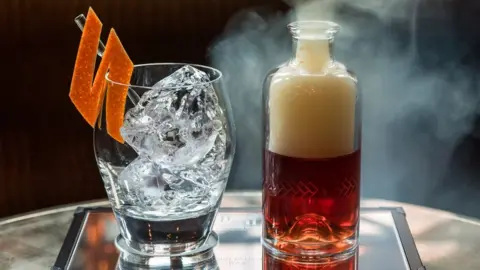 Niklas Halle'n
Niklas Halle'nThe Connaught represents the glossy, upmarket end of London's cocktail scene. It's about the experience as much as the contents of your glass.
If you order a Martini, the Martini trolley is wheeled over, and the gin and vermouth are mixed to your precise specifications. 007 would approve.
Ten years ago, New York arguably led the cocktail scene; new bars were cropping up offering freshly squeezed juices and craft spirits, often in simpler, less plush surroundings.
Now, inspiration has rippled around the globe and most capital cities boast plenty of places where the barman knows his Woo Woo from his Sex On The Beach.
So this year, competition for a place on The World's 50 Best Bars (compiled by publishers William Reed) is stiff.
"A great cocktail isn't just about the liquid in the glass," says Sandrae Lawrence, one of the competition judges and editor of The Cocktail Lovers magazine.
"It's an overall experience that you're looking for.
"Great bars come in all shapes and sizes, from neighbourhood bars, to dive bars and five star hotels," she says.
"You've got to look at hospitality, the team work, how that bar makes you feel."
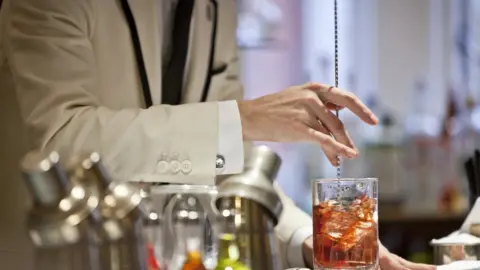 Rob Lawson
Rob LawsonAnd when it comes to the drink, as well as the chemistry and the artistry of presentation, there's also geography - where the ingredients come from; the story behind them is becoming ever more important, she says.
According to industry figures, Britons are drinking more cocktails. CGA, which collates data on the food and drink industry, says the market reached £500m last year and is growing at 10% per annum.
We're also becoming more adventurous according to CGA's chief executive Phil Tate, and eager for that "added element of theatre" on a night out, particularly in the age of Instagram.
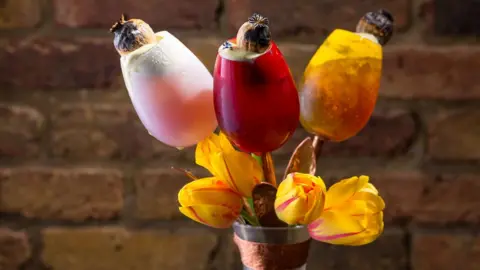 JCMT agency
JCMT agencyBut "theatre" isn't always about sumptuous surroundings.
An anonymous door off Old Street roundabout in east London, is the threshold of a more bohemian cocktail scene.
Like the rough and ready speakeasies of 1920s America, which offered illicit drinking in an era of prohibition, the tiny basement bar, Nightjar, has bare wooden floors and exposed bricks, subdued lighting and live music.
A Little Devil waits for me on the counter.
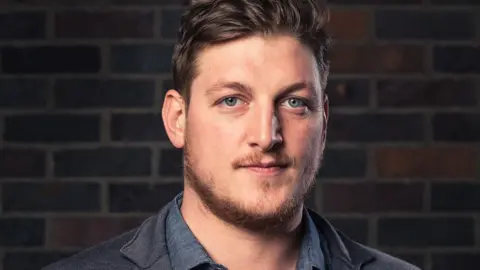 Addie Chinn
Addie ChinnAlthough the venue is more basic, the drink is far from understated: served in pewter goblet with a serpent winding its way to the top, it's a concoction of rum, the Italian herbal liqueur Amaro, the Chinese herb schisandra, and devil's claw root, commonly used as a herbal remedy.
The cocktail world can sometimes seem a little swept away by its own mythology, bartenders who "build" or "create" drinks rather than mixing them, infusions and dashes of ever more exotic ingredients.
Might they be accused of going a bit overboard, I wonder, experimenting for the sake of it, rather than for the taste?
Edmund Weil, the co-owner of NightJar says not.
"We really do go to a lot of effort to source interesting ingredients, but you do have to produce drinks with real substance which hang together perfectly," he says.
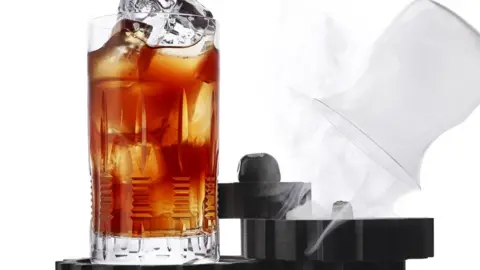 Rob Lawson
Rob LawsonWith the growing fashion for cocktails, the lower priced end of the market is booming, too.
The chain Be At One now has over 30 bars all over the country, offering cocktails for £7.50 to £11.
Be At One sold two million cocktails in 2016, up fourfold over the last five years. Its most popular is the Pornstar Martini - made with vodka, passion fruit liqueur and prosecco - representing 15% of all its cocktail sales.
But the winner of the world's best bar, voted on by over 500 experts, bartenders and waiters, was only ever going to be one of those at the top end of the market.

More stories from the BBC's Business Brain series looking at interesting business topics from around the world:

So who won?
In the end, the American Bar at the Savoy Hotel in London takes first place, its name a nod to a spirit of transatlantic conciliation. But the number two spot was taken by another London bar, Dandelyan.
New York's Nomad comes in at number three.
After celebrating wildly with his team on stage, Erik Lorincz, the American Bar's head bartender, reflects on the result.
"We look into every aspect of what we do," he tells me. "It's not just the drinks themselves, it's how we serve them and how we greet the guests and look after them."
He says he will be toasting the win with a few of his bar's house cocktails.
"I'll probably start with a Diamond Jubilee Fizz. That's Bombay Sapphire gin, grapefruit and orange oleo saccharum - a sugared oil - Earl Grey tea, lemon juice, almond syrup and champagne."

The World's best bars
1. The American Bar, The Savoy, London
2. Dandelyan, London
3. The Nomad, New York
4. Connaught Bar, London
5. The Dead Rabbit, New York
6. The Clumsies, Athens, Greece
7. Manhattan, Singapore
8. Attaboy, New York
9. Bar Termini, London
10. Speak Low, Shanghai
Source: William Reed

